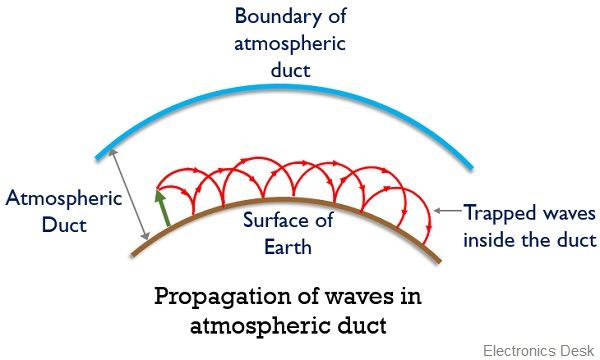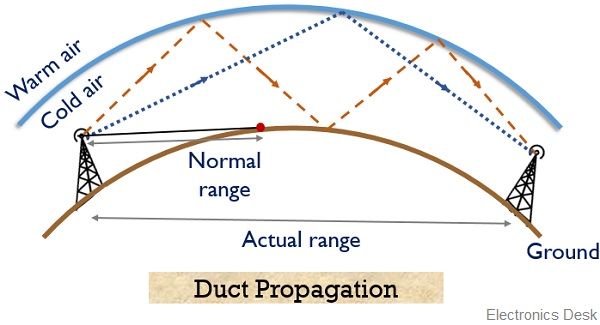Definition: A radio wave propagation technique that allows the transmission of UHF and VHF electromagnetic waves through the region near the tropospheric layer of the atmosphere is known as duct propagation. Basically in duct propagation, despite being reflected from the ionosphere or gliding over the surface of the earth, the waves propagate from an end to another by undergoing successive refraction from the troposphere.
Duct propagation is sometimes referred as super refraction. It allows the propagation of the signals beyond the horizon. This means that, unlike surface wave propagation, it permits the signal transmission without assuring the need for having a line of sight distance between the two antennas.
Content: Duct Propagation
Need for Duct Propagation
We are already aware of the fact that for frequency ranges greater than 30MHz, space wave propagation is used. This is so because such high-frequency signals despite getting reflected from the ionosphere get penetrated. Thus, space wave is utilized for transmitting high-frequency signals. But the major drawback associated with space wave propagation was LOS communication.
Due to high frequency, the signals in the troposphere require an obstruction-free path as wavelengths of such high-frequency signals are short. Thus this mode of propagation limits the range for signal transmission. So, for UHF and VHF signal transmission to an even greater distance, the duct present in the tropospheric region of the atmosphere is utilized. This duct acts as a channel to guide the high-frequency wave to the other end by successive refraction. Hence is referred as super refraction.
What is an atmospheric duct?
The atmospheric duct is the region or layer present in the lower atmosphere, which is a result of temperature inversion. The duct behaves as a waveguide in the atmosphere and guides the radio waves along the curvature of the earth thereby allowing the spreading of wavefronts in a horizontal manner only.

We know that the troposphere is generally extended up to 15 km from the surface of the earth. And the duct propagation takes place nearly about 50m above the troposphere. Thus we can say that duct propagation occurs in the troposphere and tropopause(stratosphere). Duct propagation occurs when a duct is formed in the lower layer of the atmosphere. Duct is nothing but the region of cool air present between the layers of the warm air. The formation of the duct is the outcome of temperature inversion. Now the question arises–
What is temperature inversion?
As we have already discussed that stratopause is the region present next higher to troposphere.
The temperature of this region generally remains constant. The region has a dielectric constant which is somewhat greater than 1 at the surface of the earth, as it is denser than the region of the upper atmosphere. While on moving upwards as the air density decreases to 0, the dielectric constant attains unity value. So, it can be said that dry air has a dielectric constant of more than 1 and the existence of water vapor enhances the dielectric constant further. Thus we can say that the dielectric constant is dependent on the weather conditions.
We know that in a standard atmosphere, the temperature shows reduction with height. This means with the upward movement in the atmosphere the dielectric constant must decrease uniformly. So, this will lead to have unity dielectric constant in the region of zero air density. However, practically this standard atmospheric condition shows rare existence.
The reason behind this is that the air is of turbulent nature, also there exist different layers of air. These multiple layers of air contain different water vapor contents thus different temperatures. So, the property of significantly having a decrease in temperature with height gets failed to be achieved. This leads to cause the development of an unusual situation in the atmosphere, where a layer of warm air exists above the cool air.
This is known as temperature inversion and this gives rise to the phenomenon of super refraction in the atmosphere.
What is Duct Propagation?
Duct propagation is the phenomenon of transmitting UHF and VHF signals to longer distances. We have already discussed that the presence of a layer of cool air between warm air, generates a duct that guides the high-frequency signals inside it like a waveguide.
Basically, the wave propagates inside a duct by undergoing successive refractions inside it. The change in the refractive index due to warm and cool layers in the atmosphere causes duct propagation. We have understood the unusual atmospheric conditions that cause the generation of the duct. However, for duct propagation to take place, the two necessary conditions are as follows:
- The transmitting antenna must be extended up to the region of the duct in the atmosphere and
- The angle of incidence of radio waves should be less than the value of the critical angle.
As we know that warm and cool airs possess variation in the refractive index. This is due to the variation in their densities. So, when such high-frequency wave emitted from the transmitting antenna in the region of the duct (i.e., cool air) with a low angle of incidence, then on experiencing lower refractive index from the region of warm air due to lower density, the wave gets refracted back to the surface of the earth.

Further, it is known that the air above the surface of the earth has a higher temperature, thus the warm region is present lower next to the duct. So, the wave while propagating through the cool region (having higher refractive index) towards the ground again gets refracted when interacted with the medium of lower refractive index. This sudden variation in the refractive index of the medium is due to the change in the dielectric constant of the atmosphere. This is clearly shown in the figure above.
Due to this reason, the wave undergoes multiple refractions and oscillates between the two boundaries of the duct and received by the receiving antenna. In this way, the transmitted signal gets achieved by the antenna at the opposite end with less attenuation.
In this way, duct propagation allows the transmission of high-frequency signals to larger distances without the condition of line of sight propagation. Through duct propagation, these high-frequency signals can be transmitted up to a distance of 1000 km in the atmosphere.
Explanation is super
Is there any app related to Electronics.